Introduction & Tour of the Alcor-B Foundation’s Mobile, Arizona Patient Care Facility & Existential Colony
Address given to Alcor-B Foundation Cryopreservation Members and Staff
15 September, 2012
By Gorton Carpenter, M.D., Ph.D., President of the Alcor-B Foundation
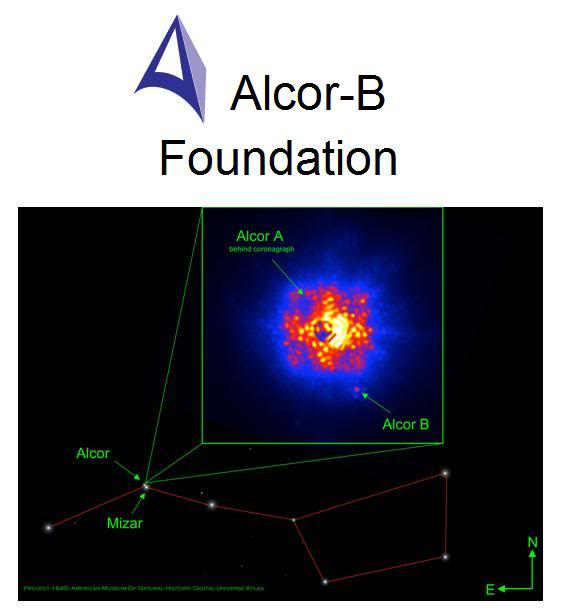 Alcor-B Cryopreservation Research Foundation (ABCRF)
Alcor-B Cryopreservation Research Foundation (ABCRF)
Figure 1: The Alcors are the second, smaller and dimmer companion stars to Mizar, the bright stars that comprise the crook in the handle of the Big Dipper constellation. In the Arab world of the 5th Century CE, Mizar’s much less bright (and more difficult to see) companion stars, Alcor-A and Alcor-B were used as tests for good vision. Only someone with the clearest and most acute visions could see the Alcor’s. Alcor-B was discovered early in 2011 using Project 1640m, which makes use of the Hale Telescope’s adaptive optics system. Project 1640 gives the Hale a view almost equal to what is possible in space. The instrument also has the ability to block out the light of a star, allowing faint objects located next to a star to be seen. The Hale, armed with Project 1640, was pointed at Alcor earlier this year and found that it isn’t a single star. Alcor has a small stellar companion that hadn’t been seen before: Alcor-B, a small, dim red dwarf star about one fourth the mass of our Sun. To see Alcor-B you must have the superior vision that only mastery of the most sophisticated technology allows. Alcor-B is thus a test for the clearest and most acute vision – vision capable of seeing things as they really are – not just as they appear to be.
 Figure 2: Alcor-B President, Gorton Carpenter, M.D., Ph.D.
Figure 2: Alcor-B President, Gorton Carpenter, M.D., Ph.D.
Why?
Now that we’ve returned from the break, hopefully refreshed and ready for a bit more technical material, I’d like to continue by explaining why we undertook to create the Mobile, AZ facility. In hindsight it seems strange that those who started cryonics were not more concerned with what could go wrong, let alone what the probability was of those things actually going wrong! Looking back at the press clippings and the media coverage from that era, it is for sure that the public had no problem identifying possible problems with cryonics.
While the average Joe may have been focused on power failures, economic calamities, nuclear war, and overpopulation as obstacles in simple-minded ways that irritated cryonicists, and caused a knee jerk reaction in them that led them to dismiss these objections. Their objections were, nevertheless, real and valid. No, our patients aren’t refrigerated by compressors that depend upon a continuous supply of electricity. But they are refrigerated by liquid nitrogen which is dependent upon the power grid– any lasting disruption to the power supply, or even rationing of electricity or, the energy commodities it is produced from – and cryonics patients warm up and rot. The difference in the outcome from the objection raised by Average Joe is only 30, or 60, or 90 days, at most. The standard response of cryonicists then, and mostly now, has been, “Cryonics facilities don’t use electricity to refrigerate cryonics patients: they use liquid nitrogen (LN2). ”
And how is Ln2 made? With electricity, of course.
And while cryonicists were quick to point out (and to take delight in) the inaccurate and foolish predictions of Malthusian doom by the “experts,” such Paul Erlich. [1] It was to no small degree because of unprecedented and unforeseen technological advances in agriculture, food distribution (computerization) and food preservation technology that that this catastrophe was avoided. What those cryonicists did not do, was to the question the wisdom of courting catastrophe, absent at least a reasonably good assurance that the solutions would, in fact, be there when they were needed.
Facing Limits & Preparing For Adverse Consequences
And of course, our contempt for this issue begged the question, “Just what are the limits to population growth, even given the most optimistic projections for the growth in food supply?” Also not considered were the geopolitical and social issues that attend disproportionate growth in the populations of some peoples, while that of others remains unchanged. Nor was there any consideration given to the social-demographic effects on populations where the majority of the citizens are in their 20s, are unemployed, are poorly educated (or not educated at all) are impoverished, and are facing a future largely devoid of hope. It is also certain that we did not consider the consequences of even a single hiccup in the food supply, such as a sustained and widespread drought, that would double or treble food prices in those same already marginally fed populations. Something that is happening right now. The result was that to an alarming extent we did not see the mass famines that now engulf much of Sub-Saharan Africa and significant parts of India. And it is certainly the case that that our predecessor cryonicists did not foresee a time when over 16% of Americans would be receiving Food Stamps (Figure 3), and that people using EBT [1] cards at the till in a grocery store would become something that everyone recognized, and that almost no one held in contempt – for fear they might find themselves with one hand in a few short months.
 Figure 3: In the closing days of 2012the percentage of Americans receiving Federal Food Stamp assistance reached 16.25% of the population, up from 14.2% in June of 2011.[2] The continued deterioration of the US and the global economy coupled with major agricultural failures in the US as a result of drought and record summer heat throughout most of the nation are the factors most immediately responsible for this situation.
Figure 3: In the closing days of 2012the percentage of Americans receiving Federal Food Stamp assistance reached 16.25% of the population, up from 14.2% in June of 2011.[2] The continued deterioration of the US and the global economy coupled with major agricultural failures in the US as a result of drought and record summer heat throughout most of the nation are the factors most immediately responsible for this situation.
Of course, this situation did not materialize out of thin air, nor did it happen overnight. We did not suddenly awake to over a quarter of this nation’s children being on Federal food assistance, with more than half of the children in Alabama and Missisippi needing Food Stamps, just to stay fed.
 Figure 4: The US median household income has been flat or in decline since 1999. Since 2007 the decline has been precipitous and sustained and this is consistent not with an economic recession, but rather with an economic depression.
Figure 4: The US median household income has been flat or in decline since 1999. Since 2007 the decline has been precipitous and sustained and this is consistent not with an economic recession, but rather with an economic depression.
TRP’s (Timeline to Rescue Project’s) comprehensive econometric analyses had long shown the indicators that this economic upheaval was coming. Median US household income has been either flat, or steadily declining, since 1999, and even more alarmingly, debt as a percentage of personal income has been rising steadily and dramatically since at least 1985 while savings as percentage of personal income have been declining over the same time period even more dramatically (Figures 5 & 6).
 Figure 5: Debt as a percentage of personal disposable (i.e., non-confiscated) income.
Figure 5: Debt as a percentage of personal disposable (i.e., non-confiscated) income.
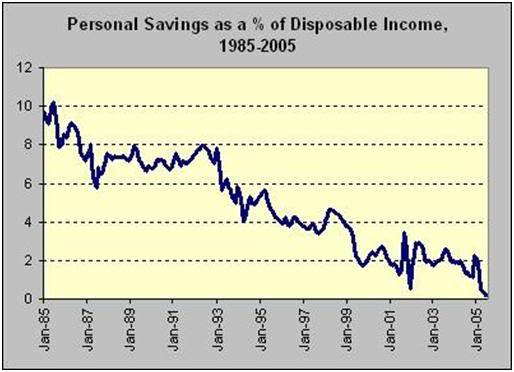 Figure 6: Personal savings as a percentage of disposable income from 1985 to 2005.
Figure 6: Personal savings as a percentage of disposable income from 1985 to 2005.
These trends might have been tolerable over a longer time course if it had not been for the fact that the same kind of fiscal irresponsibility was being practiced on the macroeconomic scale, as well. As is evident in this TRP data from 2008, the stock market began to exhibit unequivocally bubble-like behavior in the opening years of the 1990s and this behavior, as indicated by an absolutely astronomical (and unprecedented) disconnect between real value and the “market value,” as indicated by the S&P Price Index continued until 2007 (Figure 7). The problem with bubbles, economic and otherwise, is that thy burst, and that is precisely what happened to the global economic bubble in 2007.
 Figure 7: The incredible disconnect between price, earnings, dividends and probable real value of shares; and of economic wealth as a whole. Data analysis and projection by TRP.
Figure 7: The incredible disconnect between price, earnings, dividends and probable real value of shares; and of economic wealth as a whole. Data analysis and projection by TRP.
This single piece of econometric data was grounds for us to initiate the Mobile, AZ, Project. However, any uncertainty we had was further reduced when we examined the really long-term trend in the purchasing power of the US dollar (Figure 8) and compared that with foreign borrowing, and the global debt to equity ratio. When the TRP predicted sharp and steady rise in gold prices began, we knew we had to act.
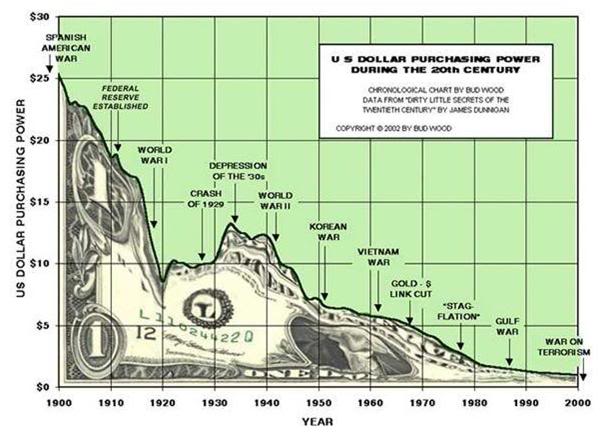 Figure 8: Purchasing power of the US dollar from 1900 to 2000.
Figure 8: Purchasing power of the US dollar from 1900 to 2000.
The decline in the value dollar has been so steady and unrelieved that it was impossible for either TRP or for Alcor-B management, to envision a scenario in which this trend would not only reverse itself, but be sufficiently large to allow for any reasonable possibility of servicing what was then $6 trillion in debt. A quick look at this slide (Figure 9) shows the hopelessness of this situation once the exponential phase of indebtedness and interest is reached; something that clearly happened around 2008.
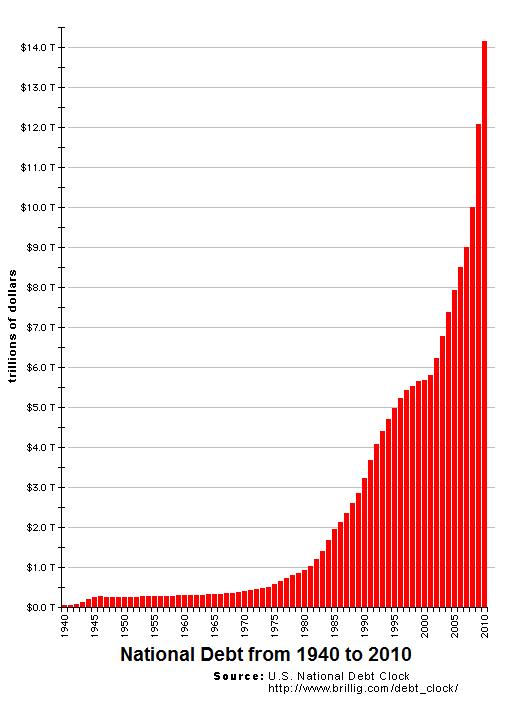 Figure 9: The US National debt as of 2010, the last year that the TRP econometricians were certain that valid data was being released by the US Treasury Department.
Figure 9: The US National debt as of 2010, the last year that the TRP econometricians were certain that valid data was being released by the US Treasury Department.
In 2008, these data, taken together, led TRP to recommend that the Patient Care Trust (PCT) increase the fraction of its assets in gold from 10% to 20% and that they restructure their real estate and securities holdings. This advice was taken, and what’s more, the PCT decided to commit half the capital accumulated from the 10% Rule to gold. That was $1.9 million in 2008 Dollars. That purchase was made in February of ’08 at a price of $865 per ounce. Half of that “investment” was liquefied on 02 August, 2011 at the peak of the uncertainty as to whether or not Congress would increase the National Debt Ceiling, at a price of $1,648 per ounce. This resulted in a net increase in working capital of $1.85 million 2010 dollars (after transaction-related expenses). In other words, the time and effort invested in TRP covered three-quarters of the cost of the Mobile Facility, including the cost of the land (150 acres x $650 acre). To paraphrase the father of cryonics, Robert Ettinger, in another context; economic depressions are only for the unprepared and the unimaginative. (Laughter)
The Final Fallback Plan
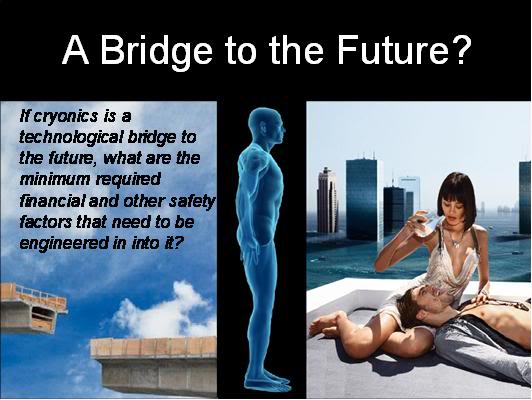 Figure 10: The analogy of cryonics as a bridge to the future, our future, implies that we must both build with enough safety factor to prevent collapse and anticipate existential crises that pose a genuine threat to its workability
Figure 10: The analogy of cryonics as a bridge to the future, our future, implies that we must both build with enough safety factor to prevent collapse and anticipate existential crises that pose a genuine threat to its workability
However, we shouldn’t be even a little smug. The current situation has the potential to deteriorate into a nightmare scenario – one that all the foresight in the world cannot prepare us for – at least not given our small size, and even smaller resources. While cryonics is our technological bridge to the future, it is, admittedly, a fragile one. And so one of the things I want to tell you about is the beginning of our implementation of our Final Fallback Position (FFP).
We have pursued cryopreservation as our method of bio-preservation for many reasons. For one thing, it was how the idea was handed to us by Ettinger and Cooper, the two men who first conceived of cryonics. They in turn were persuaded that cryopreservation was the best approach by virtue of the fact that many living systems can survive cooling to cryogenic temperatures if treated properly. And, perhaps just as importantly, both men were, understandably, hostages to the Arrhenius Equation, which states that the rate of chemical reaction is an invariable function of temperature. There’s a caveat to that though, and that is that the Arrhenius Equation only applies to systems that have molecular mobility, or in other words, to systems that are in a liquid or gaseous state. This caveat really didn’t become apparent until the era of vitrification began in cryonics in 2000. At that time, it began to sink in that systems in the solid state pretty much get a pass on the Arrhenius Equation, and it was the Arrhenius equation which had consigned stable, indefinite biopreservation to the realm of LN2 temperature, or below.
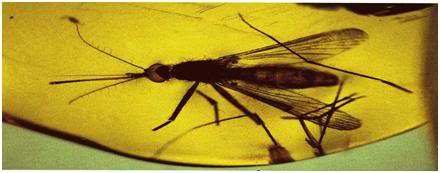 Figure 11: Culicidae: Dipter in Dominican amber ~40 million years old.[3]
Figure 11: Culicidae: Dipter in Dominican amber ~40 million years old.[3]
While it had been known since the 18th century that biological material trapped in amber was remarkably preserved, even over time periods of millions of years. However, the quality of that preservation, and the implications for cryonics, were only fully appreciated a decade ago, with the demonstration of well preserved ultrastructure in some organisms preserved in amber. [4] And even more surprisingly, it has bow been verified that intact and relatively un-fragmented DNA is also present in some archaeo-amber samples. [5-7] There is also growing evidence that viable microorganisms may be cultured from amber ~20-45 million years old [8] and, incredibly, from aqueous inclusion in salt deposits that are at least 100 million years old. [6, 9-12] These findings led to the initiation of what was initially called the Brain Plastination Project, led by Dr. Ken Hayworth, which has since been rechristened the Ambient Temperature Vitrification Project (ATVP). The goal of the ATVP was to develop minimally biochemically disruptive techniques for rendering biological tissues into the solid state – and hence biochemically quiescent. The idea was to avoid the many chemical and biophysical changes induced by fixation by skipping this step, and introducing plasticizing monomers into tissue that was in a viable, or near viable state at the start of the procedure.
 Figure 12: Buthidae: Scorpiones In Dominican Amber ~25-40 million years old.[3]
Figure 12: Buthidae: Scorpiones In Dominican Amber ~25-40 million years old.[3]
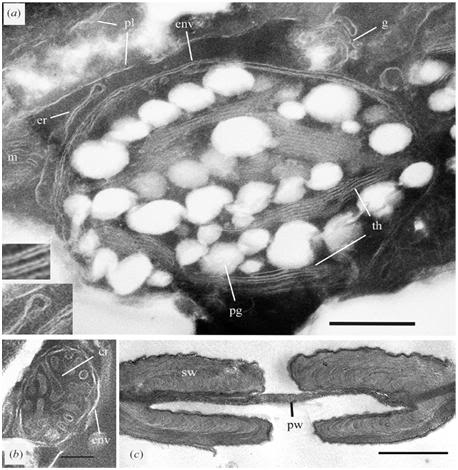 Figure 13: Cypress Plant Cell Ultra-structure: Baltic Amber ~45 million years old: http://rspb.royalsocietypublishing.org/content/272/1559/121.full.pdf and http://www.ncbi.nlm.nih.gov/pmc/articles/PMC1634957/pdf/rspb20042939.pdf [4]
Figure 13: Cypress Plant Cell Ultra-structure: Baltic Amber ~45 million years old: http://rspb.royalsocietypublishing.org/content/272/1559/121.full.pdf and http://www.ncbi.nlm.nih.gov/pmc/articles/PMC1634957/pdf/rspb20042939.pdf [4]
This work is still in its infancy, but we have nevertheless learned a great deal, some of which is directly applicable to the development of the FFP. One of most difficult problems to be overcome when applying this technique to a whole organ the size of a human brain is, how do you keep the circulatory system accessible to allow for the replacement of the water in the tissue with the monomer that will subsequently be polymerized into a solid plastic, and to remove the truly enormous amount of heat liberated by the exothermic polymerization reaction?
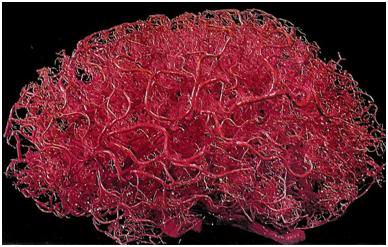 Figure 14: A corrosion cast of the circulatory system of the human brain. The extensive vascularization of the brain allows for use of the circulatory system as both a mass and heat exchanger. Gas perfusion of the circulatory system prior to cooling to vitrification temperatures leave it accessible during cryogenic storage should fixation and plastination become necessary as a fallback position to cryopreservation.
Figure 14: A corrosion cast of the circulatory system of the human brain. The extensive vascularization of the brain allows for use of the circulatory system as both a mass and heat exchanger. Gas perfusion of the circulatory system prior to cooling to vitrification temperatures leave it accessible during cryogenic storage should fixation and plastination become necessary as a fallback position to cryopreservation.
This slide (Figure 14) shows the circulatory system of a human brain. This is the real deal, not a model. What you are looking at is something called a “corrosion cast.” In this case, the arterial circulation of a human brain was injected with a red-tinted plastic material and the brain was then immersed in a strong base, such as a concentrated solution of sodium hydroxide. The base dissolves or corrodes the tissue away, leaving behind the red plastic framework of the arterial circulation. It’s easy to see that the human brain is a “strongly circulated” organ – in fact, the brain normally received 1/3rd of the resting cardiac output – about 1.5 liters of blood per minute. The FFP researchers decided that the best way to achieve both heat and mass exchange was to keep the brain’s circulatory open and accessible throughout the procedure. In order to achieve this during solidification of the brain, they turned to gas perfusion – replacing the liquid in the circulatory system with gas.
One of the investigators (Mike Darwin) realized that if the circulatory system of human cryonics patients was similarly perfused with gas during cooling to vitrification, not only would cooling be hastened, thus reducing the risk of freezing, but the circulatory system of the patient would remain accessible, even during storage at -150○C. What this meant was that it would thus be theoretically possible fix and plastinate cryonics patients in the event that cryopreservation was no longer possible.
In this scenario, a patient would be removed from storage to a special apparatus, the Final Fallback Position System (FFPS), where his arterial circulation would be connected to a recirculating system of solvent chilled to -100○C. This solvent would be pumped through the patient and would begin dissolving the viscous cryoprotectant-water solution in the patient’s tissues. The solvent would also contain fixative – initially formaldehyde to fix the proteins and, finally, a highly reactive metal, osmium tetroxide, that is necessary to fix the lipids; which comprise both the cellular and the intracellular membranes. Once the patient had been “solvent substituted” and fixed in this fashion, it would then be possible to safely warm him up to room temperature and introduce the monomer required for plastination. In fact, if necessary, this could be done by immersion, rather by perfusion (though this would necessitate removal of the brain from the head).
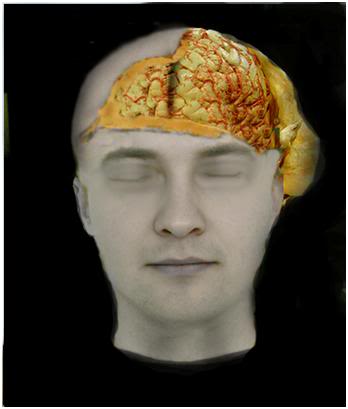 Figure 15: The head of a fresh (~1.5 hrs post-mortem) human cadaver subjected to vitrification and then deep subzero fixation and plastination with Epon epoxy resin using the FFPS. Accelerated aging tests show both ultrastructural and molecular stability in the range of 1.5 to 2.0 million years.
Figure 15: The head of a fresh (~1.5 hrs post-mortem) human cadaver subjected to vitrification and then deep subzero fixation and plastination with Epon epoxy resin using the FFPS. Accelerated aging tests show both ultrastructural and molecular stability in the range of 1.5 to 2.0 million years.
What you see here (Figure 15) is a human head that has been subjected to this procedure following vitrification. It has taken hundreds of experiments with animals, and over a dozen experiments with human cadavers to develop this process to the point that it is ready for application to cryonics patients, should the need arise. As a result of a directed donation of $850,000, we have developed the system you see here (Figure 16). This system is capable of processing up to 8 neuropatients at one time. And yes, if you are whole body and the FFP needs to be implemented, you will be processed as a neuropatient, with no ifs ands or buts. Tthe urgency of such a situation will necessarily strain our capability perilously close to the breaking point, even with our current population of 122 patients.
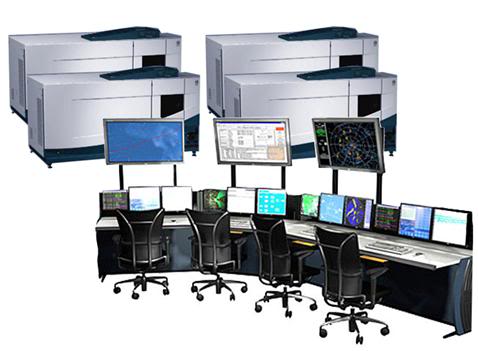 Figure 16: The Final Fallback Position System (FFPS) for the automated processing of cryopatient cephalons from the deep subzero state, to ambient temperature fixation and solidification (plastination).
Figure 16: The Final Fallback Position System (FFPS) for the automated processing of cryopatient cephalons from the deep subzero state, to ambient temperature fixation and solidification (plastination).
I want to be clear that ultrastructural studies conducted during the development of the FFPS do show considerable additional distortion of cellular architecture. The best results are obtained when the procedure is carried out without the intermediate step of vitrification. And yes, we are giving consideration to offering this procedure as an alternative to cryopreservation. However, that is a topic for another time. For now, I felt it was important that you be fully informed not only that we have contingency plans in place for the care of the patients in the event that cryogenic refrigeration becomes unavailable, but also that we now believe such a contingency has sufficient probability to warrant the considerable time and expense involved in developing and deploying this system.
You will be able to see the FFPS during the tour later today. For now, I think we should take our second break before lunch. Following lunch we will assemble here for the formal tour of the facilities.
End of Part 2
Footnotes
[1] EBT cards are Electronic Benefits Transfer cards which have almost exclusively replaced paper food stamps. They are similar to ATM cards but bear the distinctive marking of the state that issues them.
References
1. Erlich P: The Population Bomb: Buccaneer Books; 1996.
2. Bloch M, DeParle, J, Ericson, M, Gebeloff, R. : Food Stamp Usage Across the Country:http: //www.nytimes.com/interactive/2009/11/28/us/20091128-foodstamps.html. New York Times 2011.
3. R. PGaP: The Quest For Life in Amber. Reading, MA: Addison-Wesley; 1994.
4. Koller B, Schmitt, JM,Tischendorf, G.: Cellular fine structures and histochemical reactions in the tissue of a cypress twig preserved in Baltic amber: http://rspb.royalsocietypublishing.org/content/272/1559/121.full.pdf. Proc R Soc 2005, B 272:121-126.
5. Schmidt A, Schäfer, U.: Leptotrichites resinatus New Genus and Species: A Fossil Sheathed Bacterium in Alpine Cretaceous Amber. Journal of Paleontology 2005, 79(1):175-184.
6. Ascaso C, Wierzchos, J, Speranza, M, Gutiérrez , JC, González, AM et al.: Fossil Protists and Fungi in Amber and Rock Substrates:http: //digital.csic.es/bitstream/10261/33738/1/DEFINITIVOMicropaleontology_2005.pdf. Micropaleontology 2005, 51(1):59-72.
7. Lambert L, Cox, T, Mitchell, K, Rossello-Mora, RA, Del Cueto, C, Dodge, DE, Orkand, P, Cano, RJ.: Staphylococcus succinus sp. nov., isolated from Dominican amber. Int J Syst Bacteriol 1998, 48(Pt 2):511-518.
8. Cano R, Borucki, MK.: Revival and identification of bacterial spores in 25- to 40-million-year-old Dominican amber. Science 1995, 268 (5213):1060-1064.
9. Stan-Lotter H, Terry McGenity, J, et al.,: Very similar strains of Halococcus salifodinae are found in geographically separated Permo-Triassic salt deposits. Microbiology 1999), 145:3565-3574.
10. Grant W, Gemmell, RT, McGenity, TJ.: Halobacteria: the evidence for longevity. Extremophiles 1998, 2(3):279-287.
11. Vreeland R, Piselli, AF, Jr, McDonnough, S, Meyers, Ss.: Distribution and diversity of halophilic bacteria in a subsurface salt formation. Extremophiles 1998, 2(3):321-331.
12. Brown M: Molecular History Research Center: http://wwwmhrcnet/ancientDNAhtm

I hope you’re happy, because of you I am going to be late for work today! This is just an incredible blog. I only have one question about your post today and that is how do I get into contact with that Alcor-B company to make cryonics arrangements? I looked over the other Alcor’s website and the funny thing is that the most interesting things in their library look like they belong here.
Thanks for the kind remarks. I wish I could tell you where to find Alcor-B, other than inside my head, but I can’t. If you do find them, please, drop me a line and tell me where, because I’d like to sign up with them too. — Mike Darwin
The treatment is reminiscent of The Endochronic Properties of Resublimated Thiotimoline. :)
Thanks for posting this!
I’m looking forward to the sequel.